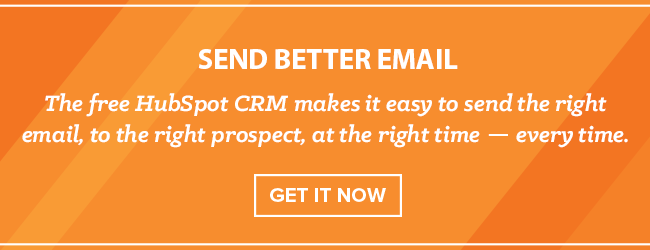Where do you get your best leads from? HubSpot recently surveyed a randomly selected sample of our sales software and CRM users on this exact question.
The results were clear: Salespeople at small businesses report inbound marketing, referrals, word of mouth, and networking -- in that order -- as their top four sources of qualified leads.

There were 347 individual respondents to the survey, including sales reps, sales managers, sales directors, business owners, and some marketers. Ninety percent of the respondents work for a company with less than 100 employees. Forty three percent also use HubSpot's marketing software. (For more information on the data collection methods and significance, click here.)
As you can see from the chart, inbound marketing was reported as the top strategy for generating the most qualified leads. A full 64% of respondents in this sample reported inbound as their best source of qualified leads. Although the survey respondent pool is biased by the high number of HubSpot customers, the results still validate the ability of inbound marketing to drive the most qualified leads at the companies that invest in it.
Despite working at HubSpot for nearly nine years, I was surprised to see referrals come in second place. I thought it would have come in first! Historically, referrals from customers are the lifeblood of any small business sales effort. Most SMB salespeople hold that referrals are the best source of qualified leads since they come with an endorsement from a mutually trusted third party. As a result, these types of leads generally close faster, spend more, and stay longer.
The next best channel? It was a tie. Word of mouth, a close cousin to referrals, garnered a 33% response. Perhaps a second cousin to referrals if you will, meeting prospects through networking efforts garnered a 33% response.
If you combine the top four lead sources (inbound marketing, referrals, word of mouth, and networking), you have a clearly powerful -- and very buyer-friendly -- go-to-market strategy for an SMB. Brian Halligan has been known to say, "The internet and inbound disproportionately benefit SMBs more than they benefit Fortune 500 companies. With Inbound, success is much more about the width of your brain than the width of your wallet." This data certainly supports Brian's statement.
Going farther down the list, cold emailing beat out cold calling. Surprising? Not really. The sheer volume of prospecting emails that salespeople are sending these days make email a more efficient -- although not always more loveable -- prospecting method. It also did not surprise me to see that cold calling was only included in the top three lead generation strategies for 26% of the respondents as its effectiveness is undoubtedly waning. But on the other hand, it's obviously still a successful prospecting strategy for some. It’s just not nearly as successful as inbound or referrals for most of these companies, as previous research from our State of Inbound report supports as well.
Only 16% of respondents ranked a lead generation service in their top three lead generation strategies. While there is nothing wrong with using outsourced lead generation services, it is rare for a smaller business to outsource this function. So, it’s not all that surprising to see this low on the list.
Rounding out the bottom of the list are tradeshows, purchasing lists of prospects (presumably for cold calling), and of course the print ad. I'll spare you the standard HubSpot anti-outbound rant on these methods. In short, this data shows that these SMBs are not investing much in these lead gen strategies -- at least not anymore.
Finally, only about 5% of respondents reported using chat to engage visitors on their website. This is certainly a missed opportunity to engage and convert more qualified leads. By using the HubSpot SnapEngage integration, HubSpot’s sales team is able to not only increase the percentage of visitors who convert to a lead, but the people who engage via chat close at 2x the normal rate.
To me, the takeaways from these results are clear. First and foremost, salespeople benefit immensely when their companies invest in inbound marketing. In addition, as expected, salespeople still rely heavily on referrals from clients, networking with peers, and word of mouth for quality leads. By combining these tried-and-true referral generating methods with inbound, companies can build a highly qualified funnel of inbound leads. And as these respondents reported, these channels are more effective at sourcing qualified prospects than cold calling and cold emailing.
But, these methods are not just better for the seller. The beauty of these lead generation channels is that they are all permission-based inbound methods. That makes a lead generation strategy based around these sources better for the buyer too. The case for interrupting prospects with a pitch via a cold call or cold email is getting awfully shaky … and should really only be a last resort.
Since inbound is better for the buyer and the seller, I’m frankly perplexed that so many companies are investing in cold calling when they could and should be investing in much more scalable, repeatable, and compoundable inbound methods. Perhaps we still have some work to do in educating companies how to generate more inbound leads than they need. Challenge accepted.
What lead generation sources generate the most qualified leads for your business? How does your company leverage these different lead generation methods? Do you still need to cold call? Share your thoughts in a comment below, or join our brand new Slack channel, and engage with the inbound sales community.
Inbound Sales




.jpg)
.jpg)




![The True Cost of Not Meeting Your Customers' Expectations [Infographic]](https://53.fs1.hubspotusercontent-na1.net/hubfs/53/00-Blog_Thinkstock_Images/Customer_Experience_Edit.jpg)
![The Single Most Critical Factor For Closing Sales Deals [New Survey Data]](https://53.fs1.hubspotusercontent-na1.net/hubfs/53/handshake-4.jpg)